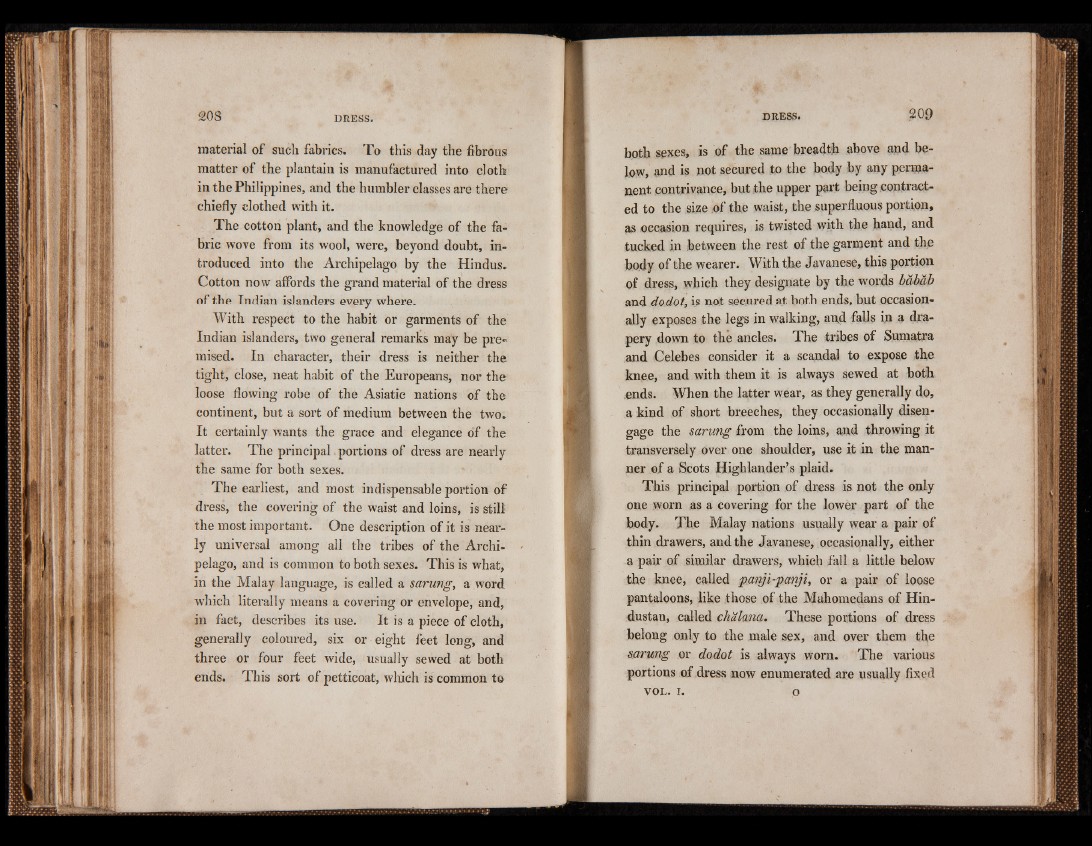
material of such fabrics. To this day the fibrous
matter of the plantain is manufactured into cloth
in the Philippines, and the humbler classes are there
chiefly clothed with it.
The cotton plant, and the knowledge of the fabric
wove from its wool, were, beyond doubt, introduced
into the Archipelago by the Hindus,
Cotton now affords the grand material of the dress
of the Indian islanders every where.
With respect to the habit or garments of the
Indian islanders, two general remarks may be premised.
In character, their dress is neither the
tight, close, neat habit of the Europeans, nor the
loose flowing robe of the Asiatic nations of the
continent, but a sort of medium between the two.
It certainly wants the grace and elegance of the
latter. The principal portions of dress are nearly
the same for both sexes.
The earliest, and most indispensable portion of
dress, the covering of the waist and loins, is still
the most important. One description of it is nearly
universal among all the tribes of the Archipelago,
and is common to both sexes. This is what,
in the Malay language, is called a sarung, a word
which literally means a covering or envelope, and,
in fact, describes its use. It is a piece of cloth,
generally coloured, six or eight feet long, and
three or four feet wide, usually sewed at both
ends. This sort of petticoat, which is common to
both sexes, is of the same breadth above and below,
and is not secured to the body by any permanent
contrivance, but the upper part being contracted
to the size of the waist, the superfluous portion,
as occasion requires, is twisted with the hand, and
tucked in between the rest of the garment and the
body of the wearer. With the Javanese, this portion
of dress, which they designate by the words bahab
and do dot, is not secured at both ends, but occasionally
exposes the legs in walking, and falls in a drapery
down to the ancles. The tribes of Sumatra
and Celebes consider it a scandal to expose the
knee, and with them it is always sewed at both
.ends. When the latter wear, as they generally do,
a kind of short breeches, they occasionally disengage
the sarung from the loins, and throwing it
transversely over one shoulder, use it in the manner
of a Scots Highlander’s plaid.
This principal portion of dress is not the only
one worn as a covering for the lower part of the
body. The Malay nations usually wear a pair of
thin drawers, and the Javanese, occasionally, either
a pair of similar drawers, which fall a little below
the knee, called panji-paryi, or a pair of loose
pantaloons, like those of the Mahomedans of Hindustan,
called chdlana. These portions of dress
belong only to the male sex, and over them the
sarung or do dot is always worn. The various
portions of dress now enumerated are usually fixed
v o l . i . o